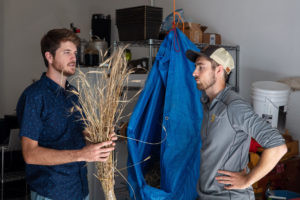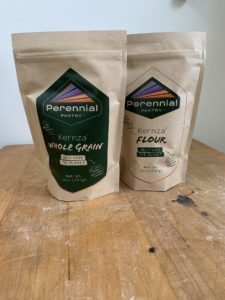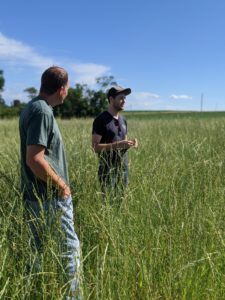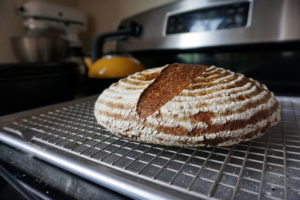Interview with Perennial Pantry
An Interview with Christopher Abbott and Brian Hedberg, Co-founders of Perennial Pantry
This interview is part of a series which highlights the work of various individuals and organizations within the Kernza® network. Through these interviews, we aim to share and celebrate that there is a large and ever-changing ecosystem that moves Kernza® perennial grain forward. If you would like your organization’s work to be featured in an interview, please email Sophia Skelly. To learn more about the Kernza® network, visit our directory.
What is Perennial Pantry and how did it evolve out of Sprowt Labs?
Christopher: Perennial Pantry is our direct to consumer brand and Sprowt Labs is our work developing processing equipment. We also work on Harlan Grains, which focuses on reviving unique, annual grains to serve as bridge crops. We’re in the process of getting all of these initiatives under one umbrella company – Perennial Foods. But, to give you a little background, we started Sprowt back in 2015, in a basement in South Minneapolis. Brian had worked in software but had studied agriculture previously. I was fresh out of school and had been working on farms. We both were really interested in landscape change in the midwest. For me, it came more from growing up in rural Minnesota surrounded by corn and beans and feeling some sense of responsibility of being from this place that has all of this huge, quiet impact around us that’s quite monotonous and destructive. I had spent time in local food and dairy/veggie farms and felt like that’s all great but not addressing the large-scale, core issues.
Brian: And I think we really bonded at the time around the idea that…[grain] was something that wasn’t really being addressed in the local food sphere. It felt like the focus was on local tomatoes and zucchini and cucumber, which is all great but we both came at it from a standpoint of wanting to make this large-scale, landscape-changing impact on the world and yeah, we thought that Sprowt Labs would be our foot in the door to be able to start making that impact through beer and through the malting world. That’s kind of how the idea of Sprowt Labs was born.
Christopher: We felt like craft food is exciting. Craft beer is exciting. But they aren’t really talking to each other and it’s an opportunity to say hey, this is truly a local beer. The main ingredient in the vast majority of craft beer is either imported across the Atlantic or it’s local, craft and the main ingredient is from a mega, 20,000 acre farm, processed by a multinational company. So, we tried to figure out: What does really small-scale equipment look like to try and accelerate local supply chains? How can we take this complex process of malting–which basically makes sugars available inside of grains for brewers to use–more accessible so that more interesting grains can be used, local grains can be used, stories can be told.
That was a whole, many-year affair of figuring out how you manufacture equipment and bring it to market and along the way we started growing a lot of heritage, small grains: getting 5 gram samples of seed stock out of the USDA out West, growing it out and seeing diversity, playing around with it and telling those stories under Harlan Grains. And I think throughout all of that period, we were trying to figure out the complexities of grain supply chains. Tomatoes are like…you pick a tomato and then you eat it. But for grains, we require all of this equipment and complexity just to get to something like flour or malts, and then you’re not even done!
We both have been interested in Kernza® for a while…I think we both felt like it was…too big of a deal or too far away, or not accessible.
Brian: We both had Kernza® products at Birchwood Cafe and Dumpling and Strand noodles. Neither of us really realized that the Kernza® wasn’t quite as big outside of Minnesota. I think our perception was like: Oh, well, we’d love to go after Kernza® but it’s already everywhere. So we missed that boat.
So when we discovered that it is somewhat still in its infancy–even though, you know, you guys have been working on it for decades. I don’t want trivialized that you guys are doing, but it’s not wheat yet. And when we realized that there’s still this big opportunity that we can be a part of. I think that was a huge mental leap for us, like a game-changer from a business perspective.
Christopher: Then in the spring of 2019, it just so happened that I’m in a men’s group down in Northfield where I live and two guys in that group are friends with Tessa and Colin Cureton at the University of Minnesota. So, it was two great connections to folks right at the center of commercialization and supply chain work. Then we started talking mostly with Tessa about malting and about whether you could increase usage of Kernza® for breweries and bring actual utility to making beer by malting it and what would that look like?
Then things just sort of grew from there. Colin, in the fall, was looking for help on where to store all of the crop that the U had contracted. So we decided we were gonna keep working on our equipment. But, I think a big lesson from our equipment is that supply chains are so tricky and…we were trying to solve a technical problem to enable other people to be the processors and tell the stories and move stuff forward. And I think one big lesson from that is that it’s tricky to leave that other work to other people who might not exist, or who might not want to make it happen or care as much.
I think that that really showed us that if we want to help make a larger impact, I think that we have to take it through the entire supply chain. It’s not that it’s easier because suddenly the processing equipment exists. I think it’s easier because [the consumer] can buy pasta or combine flour or can buy an immediately useful ingredient.
So when Colin was looking for help, we decided to jump in and figure out how to become a food safe space and help with distribution, not processing at that moment, but just getting grain through to the breweries and bakeries and folks who are wanting to work with it. We did a few really small experiments with malting the grain. It felt like, okay, there’s an opportunity here. And we had previously applied for a crop research grant through the Minnesota Department of Agriculture to look at malting the heritage grains that we had been growing. So we were familiar with that application and decided to apply again, but focus entirely on Kernza®. So then, in February of this year, we got that grant to be able to spend a few years really figuring out Kernza® malting on our equipment.
And then COVID hit and it felt like, well, we had spent all this time figuring out wholesale distribution and Brian getting all of the licensing stuff solved on our website. And it didn’t feel like we were about to sell any Kernza®. Everyone was shut down. We had wanted to move towards direct-to-consumer and being a processor ourselves and so it was just sort of the perfect opportunity to just go for it.
Brian: It kind of felt like it was our plan already. COVID almost forced us to jump forward several months. So it was kind of fortuitous from that standpoint, obviously not in the world..
Just to clarify, was the grant you received focused on processing Kernza®?
Christopher: The grant is not to develop equipment. We’ve got the equipment: we manufacture it, we sell it. That’s really what Sprowt Labs is. The grant is to research Kernza® malting itself and using culinary applications. And that’s ongoing; it’s going to be a background thing over the next few years. Perennial Pantry was really the chance to build our own processing line and processing facility and start selling direct to consumer.
We built some dehulling equipment and cleaning equipment: some of it that we had designed, some of it that came from open source designs from folks in the seed world. There’s a color sorter prototype right off camera!
Can you talk a little bit about how you decided to structure the crowdfunding campaign and the citizen science component of it?
Christopher: Yeah! I think that’s something that we both love about working on Kernza® compared to malting equipment. There is so much more of a large community making this thing happen. And we’re really just one piece of a puzzle and could not be here without everyone else also doing their things. I think that just feels so much more engaging and optimistic. There are so many people solving so many different problems to be able to move this whole thing forward. So it just made a lot more sense to us to be able to try to launch something in partnership with The Land Institute and the Artisan Grain Collaborative and Beth Dooley. And take it as an opportunity to engage a lot of other people who have known about Kernza® for a long time.
 And we had done some citizen science stuff in the past when we first started growing heritage grains with this Harlan Grains project. We had, I don’t know, 30 growers across the U S who were home brewers that we sent seed out to and engaged in seeing how these different old, old varieties would grow. I think that that was both cool and exciting and engaging….but you know, we got a little bit of seed back but a lot of people had their plants destroyed or not harvested or molded or whatever. So I think that’s sort of a lesson in like, that’s cool…you can do that. I think you have to be more careful about who you select. And if you take the complexity out and it’s more like cooking or baking or something that’s more immediately accessible and less like….”Hey, you’ve never grown grains before grains, do you want to grow grains?” It feels like it can be a lot more successful. Being able to say: you can take a survey, you also can just take a picture and use the hashtag. So I think that feels lower risk for people and, and people are participating in this thing legitimately and helping create demand for grain and they can provide feedback, but also tell the Kernza® story and help spread it out to more people.
And we had done some citizen science stuff in the past when we first started growing heritage grains with this Harlan Grains project. We had, I don’t know, 30 growers across the U S who were home brewers that we sent seed out to and engaged in seeing how these different old, old varieties would grow. I think that that was both cool and exciting and engaging….but you know, we got a little bit of seed back but a lot of people had their plants destroyed or not harvested or molded or whatever. So I think that’s sort of a lesson in like, that’s cool…you can do that. I think you have to be more careful about who you select. And if you take the complexity out and it’s more like cooking or baking or something that’s more immediately accessible and less like….”Hey, you’ve never grown grains before grains, do you want to grow grains?” It feels like it can be a lot more successful. Being able to say: you can take a survey, you also can just take a picture and use the hashtag. So I think that feels lower risk for people and, and people are participating in this thing legitimately and helping create demand for grain and they can provide feedback, but also tell the Kernza® story and help spread it out to more people.
Brian: Well, and also leveraging what you guys do. I mean that’s your forte. You all interact with people frequently in this way. You’re better set up to handle this kind of campaign than we are. So we’re kind of harnessing the capacity of the community and that’s something that’s been really enjoyable about working with Kernza®. We kind of had this surreal experience early on when we were starting the campaign where we were on this video call about our crowd funding campaign. And everyone else was just like talking and strategizing and helping out. And we were like…we’re not even doing anything yet….after several years of pushing really hard on this equipment and feeling like it was kind of us working alone, it was just so invigorating to be part of a community that felt like they were pushing us instead of us pushing against a rock.
Do you have any key takeaways from working with and processing Kernza®?
Christopher: I think an average Kernza® seed is like 1.4–1.6 milligrams and corn is ~230 milligrams. In current grain processing infrastructure, it’s all about bushels per hour. And I think often in minds, it’s all about weight–technically not weight, technically density–but in reality, it’s kernels. So in thinking about something like a color sorter, if you process a thousand pounds of corn, it’s really the number of kernels that a camera’s looking at for the number of kernels shaken through a screen and falling through little holes. So since Kernza® is so much lighter, you still have to process that same number of kernels. You just end up with way less weight than you’ve processed at the end of the day. So I think that that’s one unique challenge. On a color sorter, how do you look at more kernels than existing equipment is looking at or how do you process it faster and how do you do it more exactly if you’re dealing with such a tiny thing?
So I think that that poses unique challenges. I think what we’ve seen in grain infrastructure–and with all of the different folks trying to figure out local grain supply chains across the country–I think often it can be a mindset of….”buy the stuff from the 1960s–1980s and repurpose it and make it work.” Buy the cheaper, older, broken technology, fix it and get it to the point where we can use it locally. I totally get it, that you have to be scrappy and you don’t want to spend a ton of money to get something up and running. And I think that in the same way where you guys are thinking about agriculture completely differently, I think there’s a similar opportunity to think about supply chains totally differently. And certainly that can be relationships and fairness and equity and power and those sorts of things. But I think it also can also just be, literally, how are we doing this? Can we use new technology? Can we be scrappy and build it ourselves so that it’s not an enormous investment? And an enormous investment that can’t really be justified right now….like a color sorter! A new color sorter is like 100K. And you can probably only process tens of pounds of Kernza® on that kind of thing. So Kernza® would be astronomically expensive if that was the way that you’re going about it. I think it has to be sort of a scrappy, uncertain, innovative path forward to figure out how to affordably build out infrastructure early on that isn’t just taking in old broken machines from decades ago.
Looking into the future, do you all have any specific plans or exciting new ideas for all things Kernza® and perennial agriculture?
Brian: My brain just exploded…too many things!
Christopher: Yeah, we have some ideas….
In terms of Perennial Pantry, such a big thing to us is: How do you get Kernza® to people? Retail. That’s long-term how you make grocery shopping easy. And certainly we can work with smaller retailers right now. But with larger retailers, there’s not really going to be a way in until it’s a much more solid supply chain and folks are going to say: “Okay, if I’m giving you shelf space in a lot of stores, it better be full with product year round.” So I don’t think retail is realistic for a bit. So something like direct-to-consumer is great. We can tell a story right to the end person. We can get to know the community of folks who are making Kernza® happen. But there’s only so many people who are gonna buy just flour on a website. For us the question is: how do you bring on other products? How do you bring on more affordable products and how do you make Kernza® even easier to use? How do you have Kernza® pasta that is suddenly attractive to many more people? Or how can Perennial Pantry say “you, aren’t just buying flour! We’ve got a pancake mix, we’ve got all purpose flour, we have crackers.” One of our growers lives near a mid-scale local processing facility and we’ve been talking to him about Kernza® beef sticks and being able to tell the grazing side of the story. 
I think our goal is to mix in some regeneratively grown annual crops in the very near future, and try to, as soon as possible, build out more of a pantry of items that can either be perennial or can tell a story of farmers who are setting themselves up to become perennial, as the seed and the markets and all of those things continue to mature. So how can we tell that transition, bridge story and the perennial story, currently? How can we just make it even easier for folks to embrace this new form of agriculture…
Brian: And then as we’re creating this easy path for consumers, I think there’s also in the background this thought that we are still part of a larger change, like changing agriculture. And we do want to fundamentally change the way that people experience their interaction with agriculture. So there’s this balance between giving customers something that is an experience that they’re accustomed to, and it’s easy. And also trying to create a new world at the same time, both through our connections with farmers, but also how we’re telling our stories and how we’re communicating what makes Kernza® different. I think that’s something that’s always in the back of our minds. I think it’s a really, really amazing opportunity to be part of that. Even if we don’t have a specific plan or one thing we can point to, I think it’s kind of this constantly evolving, moving target, trying to strike that balance.
So if someone reads this interview and they want to buy flour from you all: Is the campaign ongoing? Is there still flour available? What does that look like at the moment?
Christopher: It’s ongoing. Brian will launch a non-campaign version of the website pretty soon. That will just be transitioned into a normal shop. yeah, We just expanded recently into a second unit that we’re in right now that has, I don’t know, 18,000ish pounds of Kernza® in the back end. Our employee Nick is in the other unit, dehulling a lot of grain right now. So we have some amount on stock that’s bagged and ready and we’ll have it constantly available now.